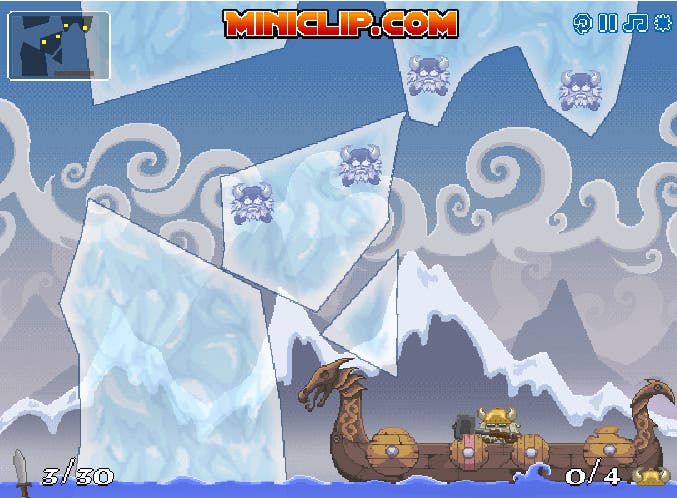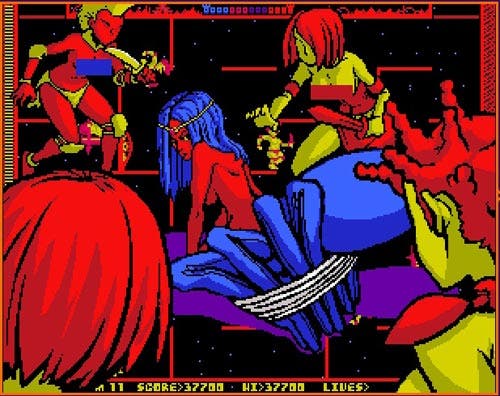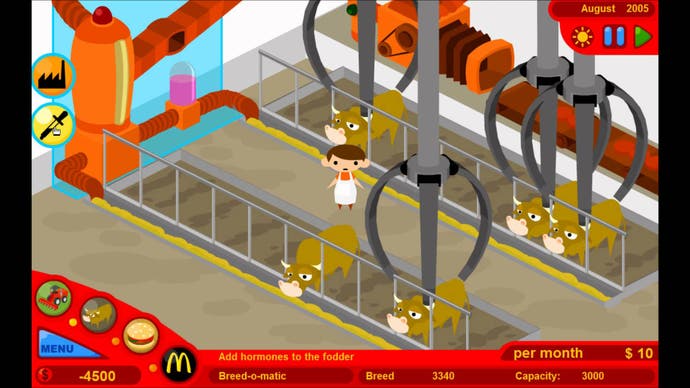Why the spirit of Flash gaming must never die
Unicorn country.
From around 2009 to 2011 I edited a Flash gaming blog called Flytrap for AOL. A belated effort to expand the company's then-considerable downloadable games business, Flytrap was a tawdry, clumsy little thing, all celebrity plugs and clunky-to-implement gallery modules plus the odd dollop of tabloid sleaze. We had daily knock-knock jokes, FarmVille diaries and a section entitled "Hot Manly Action", though no outright softcore content, thank god. I didn't think too much of my work on Flytrap at the time - it was just there to fill gaps between articles on Real Games like Dead Space 2 or Uncharted. In hindsight, though, it's clear that I had my heart in the wrong place. Games like Uncharted may be the industry's obvious peaks, but the ocean they're poking out of - the bubbling creative firmament without which this artform would be truly impoverished - is Adobe Flash.
For many players today, of course, Flash is trash - a rickety plug-in for advergames and obnoxious video pop-ups that has been steadily sidelined by the major browser companies. Just look at the popular outcry, or lack thereof, over the announcement that Adobe will discontinue support in 2020. It's worth, then, a quick refresher on what Flash has meant and means. For starters, Flash once meant YouTube. The video service that now attracts around 400 hours of accumulated viewing time a minute began life as a Flash app in 2005 (the first ever YouTube upload, a video of a co-founder's trip to the zoo, is still available today and a peculiar artefact indeed). Flash also meant FarmVille, the greatest of Facebook's bucolic time-wasters, and Candy Crush Saga, which made its debut on King.com in 2010. In fact, there was a period when Flash meant so-called "rich" - that's to say, animated and/or interactive - browser experiences full stop.

In a fascinating hour-long GDC presentation from this February, Kongregate.com's director of premium games John Cooney estimates that in 2009, 99 per cent of computers with net connections had Flash installed. It's easy, then, to see why so many up-and-coming coders opted for Flash in the noughties. The installed base of the most successful console ever is chicken feed by comparison, and for a time, the Flash scene was accessible in a way even dedicated middleware tools and development communities on PC couldn't rival. There were no publishers to appease - once you owned the development tools, all you had to do was upload your game to a site. As Matthew Annal, co-founder with Heather Stancliffe of venerable Flash developer Nitrome, recalls: "When I set up Nitrome I wanted to make original games and though I toyed with J2ME for mobile, Flash was really the only space at the time where you could make smallscale original games and find enough audience to turn a profit."
The primordial version of the software, FutureSplash Animator, wasn't really designed for game-making at all - created by Jonathan Gay in 1996 following an ill-fated attempt to break into pen computing, its key feature was support for network-based animations run with a simple scripting language. Over time, however, Gay, his studio FutureWave Software and parent company Macromedia added more options, culminating in the debut of a "proper" game toolset, ActionScript, in 2000. The toolset grew alongside the rise of Flash animation and gaming portals like Newgrounds and Miniclip - its critical update perhaps being ActionScript 3.0, which offered full integration with ECMAScript, a programming language specification that is, in the form of JavaScript, foundational to the world wide web.
"Initially I kind of stumbled into Flash but got I guess 'serious' about it right after ActionScript3 came out," Adam Saltsman, creator of Canabalt and the forthcoming Overland told me when I emailed for his thoughts on the software's retirement. "ECMA is a fun and sloppy standard for a scripting language - see all the shenanigans you can do in JavaScript, for example - and ActionScript3 gave you bitmap-level/pixel-level access for both imported assets and display/output. And it was... nominally cross-platform. And ran in the browser. And if you didn't use big music files, the game sizes were quite small - Canabalt was a few hundred kilobytes maybe. So for somebody looking for a kind of sandbox for doing rapid development or iterative development, and wanting to share games with online communities and solicit feedback and gauge reactions, it was kind of a dream come true."

It helped, of course, that the Flash toolset was so affordable. "Eventually they made the AS3 compiler for free, so if you were programming-minded you could literally make Flash games completely for free. No revenue share if your budget is too big or whatever hanging over you. This kind of ecosystem I think helped produce a lot of excellent third party libraries (like Box2D, for example)." Saltsman himself would release a free ActionScript development library, Flixel, in 2009, which has been used for hundreds of games.
Early Flash gaming was rife with copyright theft and cut-throat business tactics - it was common for pirates to ask for bribes to remove games from portals that ranked higher on Google than the developer's own site. Website ads were more profitable than they are now, but licensing deals were also much less generous. Across 2005-2007, however, the arrival of professionally-run platforms Mochi Media and Kongregate plus the Flash Game License marketplace helped stabilise the market, sparking what Cooney styles a "renaissance". By the end of the decade, the biggest Flash games could attract upwards of $100,000 in licensing fees, and a significant minority of Flash game developers were able to work full-time. There were more ways to earn money, too, including the ability to make payments within apps - the beginnings of the free-to-play craze, and a formative influence on mobile gaming, to which many Flash game studios would eventually gravitate.
It was a good time, all told, to be running a Flash gaming blog. Among my favourites from that period are the first real-time physics puzzlers, or "phuzzlers" - games like Crash the Castle, in which you launch boulders at stacks of masonry to squish Monty Python-esque nobles, or Nitrome's delightful Ice-Breaker, in which you must slice up the level to free frozen vikings. There were the viral sensations, like the famously stupid limb-simulator QWOP or Adult Swim's joyous Robot Unicorn Attack, and build-and-share games like Line Rider, where you'd pencil in a course for others to skate down. There were point-and-click extravaganzas like Samorost from Czech developer Amanita Design, a fungal fairytale with lush background art. There were philosophical platformers like Coma, a tour of a pastoral dreamscape with some beautifully considered audio. There were an astonishing quantity of games with political and social themes, from Molleindustria's powerful investigations of the fast food industry through geopolitical sims like Oil God to a small avalanche of interactive satires about Israeli occupation of the Gaza strip.

As that list of strange bedfellows suggests, there was an awful lot of experimentation and sharing, with relatively few overarching publisher or platform-holder preoccupations to worry about. "The Flash dev community has always been fantastic," notes Matthew Annal. "Everyone wants to help each other and show off new techniques. There was always someone trying to do things that were not designed for the platform. Way back before Adobe introduced 3D there were many 3D tricks going from SNES-style mode 7 to proper 3D texture-mapped objects. Whenever we had a problem at Nitrome the answer was always online somewhere, or someone was willing to help. Many events sprung up around the platform, too, and it was always great to meet with these like minded people. I think a big part of this was there was never a reason to not get on with other studios. It never really felt like we were in completion for anything, so everyone wanted good things for other devs."
Many of today's better-known "indie" developers cut their teeth on Flash. Ed McMillen worked on dozens of Flash titles before hitting the big time with Super Meatboy and The Binding Of Isaac: I particularly love Time Cfuk, a room-based platformer with a time travel element which bills itself variously as about "finding logic in irrelevance" and "communication with people who you don't like". Other standouts include the self-explanatory text adventure Don't Shit Your Pants, whose developers would go onto make cult hit roguelike Rogue Legacy, and Terry Cavanagh's Don't Look Back, a descent to the underworld.
Some Flash games, such as The Behemoth's Alien Hominid or Thatgamecompany's Flow, have made their way to other platforms; others have been updated to run on HTML5, long trumpeted as Flash's successor. But sadly a large number of these titles are at risk of being lost forever. Last year, Apple, Google, Microsoft and Firefox announced or implemented plans to block Flash on their browsers. Apple in particular has always been eager to pull the trigger on Flash, regarding it as technically deficient, a security liability and a threat to its own app business: in 2010, Steve Jobs penned a legendary 1700 word takedown, commenting that "the mobile era is about low power devices, touch interfaces and open web standards - all areas where Flash falls short" (Adobe retaliated with some fairly cheeky adverts).

Most Flash developers would agree that as a piece of technology, Flash has had its ups and downs. "Linux support was a disaster," Saltsman says. "There were like, three different weird ways of producing desktop apps from your web plugins; games could be decompiled very easily (I guess this was a pro and a con in some ways); it was surprisingly un-robust in terms of traditional game loops (without third party libraries, I mean); the sloppiness of the language was very fun but could also massively ambush you at the worst times; performance could be unpredictable and extremely black-box-y, etc." These are negligible downsides when set against the ethic of adventure, freedom and camaraderie that grew up around Flash, however - qualities that are always worth striving for, even as the app itself fades into obscurity.
"I'm not sure it will be remembered as such," says Annal, "But in my mind Flash paved the way for both modern indie games and free-for-all-style app stores. I guess the legacy of Flash is possibly that it led to the self-published indie movement we see today."

